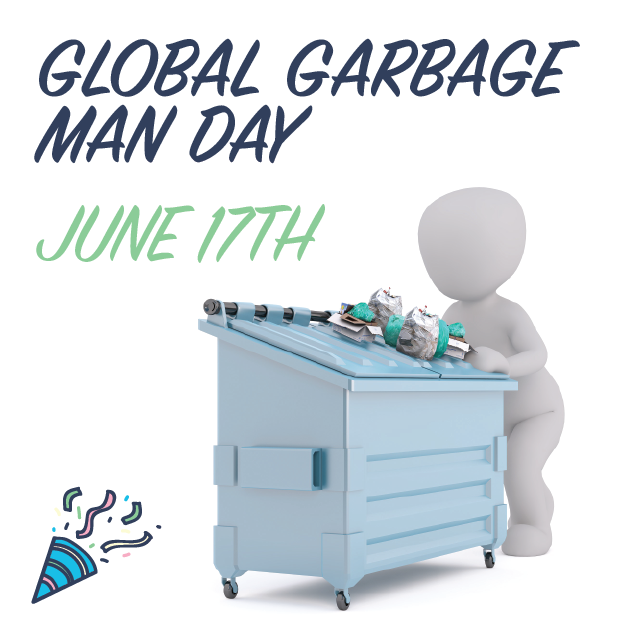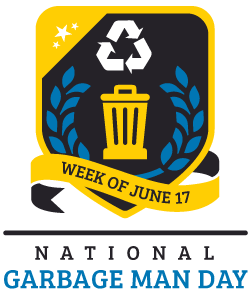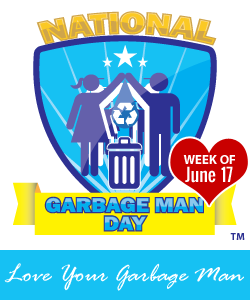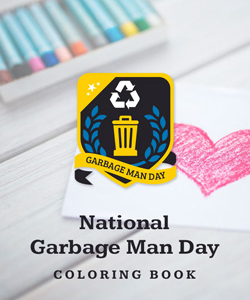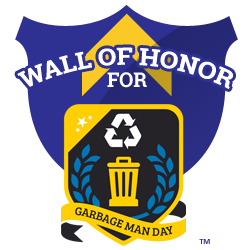HAPPY GLOBAL GARBAGE MAN DAY! Join us as we celebrate the brave people who haul away all the crap we don’t want anymore. Today we’re celebrating with the best sister in the world, Amy Cowan (Twitter: @aacowan / RereadingMyChildhood.com)! Let’s party!
BONUS AUDIO
Show Notes
History + fun facts about the holiday
- According to nationaldaycalendar.com and garbagemanday.org, John D. Arwood founded National Garbage Man Day in 2011 to honor those working hard in the industry to keep communities safe and clean. Recognizing efforts around the world, the celebration recently became Global Garbage Man Day.
- According to Wikipedia, a garbage man “is a person employed by a public or private enterprise to collect and remove waste and recyclables from residential, commercial, industrial, or other collection site for further processing and waste disposal.”
- There are many English variations on the job title. In American and Canadian English, they may be known as: garbageman; garbage collector; trash collector; trashman; recycling tech; toter tipper; shaker (shaking barrels empty); sanman (sanitation man), sanitation engineer; green machine
- In British and Irish English: dustbin man; bin man; rubbish man; midden man; dustman; refuse collector; trash trolley
- In Australian English: garbage collector; garbageman; garbo; jockey or runner; garbologist
- While we’re on the topic of garbage terms, “poubelle” is the standard French term for garbage can, which derived its origin from Eugene Poubelle, a French official who ordered in 1884 that all Paris landlords must supply their tenants with covered garbage containers
- Waste management deals with all types of waste, including industrial, biological, and household
- Waste is produced by human activity, and waste management is intended to reduce adverse effects of waste on human health, the environment, or aesthetics
- Throughout most of history, the amount of waste generated by humans was insignificant due to low population density and low societal levels of the exploitation of natural resources
- Common waste produced during pre-modern times was mainly ashes and human biodegradable waste, which were released back into the ground locally with minimum environmental impact. Tools were generally reused and passed down generationally
- With the advent of industrialization and the sustained urban growth of large population centers in England, waste in the cities caused a rapid deterioration in levels of sanitation and quality of urban life. The streets became choked with filth due to the lack of waste clearance regulations
- Calls for the establishment of a municipal authority with waste removal powers occurred as early as 1751, when Corbyn Morris in London proposed that, “…as the preservation of the health of the people is of great importance, it is proposed that the cleaning of this city, should be put under one uniform public management, and all the filth be…conveyed by the Thames to proper distance in the country.”
- It was not until the mid-19th century that the first legislation on the issue emerged, thanks largely to devastating cholera outbreaks
- Early garbage removal trucks were horse-drawn open bodied dump trucks. They were motorized in the early 20th century and the first closed body trucks to reduce odors were introduced in the 1920s.
- Curbside collection is the most common method of disposal in most parts of the developed world in which waste is collected at regular intervals by specialized trucks
- There are two disposal methods: landfills and incineration
- Garbage collection regularly charts among the top most dangerous jobs. From a January 2019 USA Today article, refuse and recyclable material collectors ranked 5th in the top 25 most dangerous jobs in the US, reporting an average of 34.9 per 100K workers suffering fatal injuries on the job. In 2017, there were 30 fatal injuries and 1340 nonfatal injuries
- They fell behind only roofers, aircraft pilots/flight engineers, logging workers, and fishing workers
- Most injuries are transportation related, but also include exposure to contaminants and other hazards, such as broken glass, medical waste, caustic chemicals, falling objects from overloaded containers, diseases accompanying waste, asbestos, dog attacks, pests, inhaling dust/smoke/chemical fumes, inclement weather, traffic accidents, and unpleasant smells that can make someone physically sick
- In summer, they have to stay constantly hydrated to avoid heat stroke. In winter, they have to take precautions to avoid frostbite
- From an AskReddit post titled, with the [serious] tag: Garbage Men of Reddit: Have you ever found anything that was so sketchy you reported it to the police? What was it? Here are a few gems:
- A body!
- A residential can half full of several hundred Sudafed boxes
- WWI and WWII grave marker medallions
- Dead animals
- 50-75 dead rats
- A rejected prosthetic limb
- Guns
- Lots of drugs
- “Hamburger like leftovers”
- Someone’s cremated ashes
- Porn
- The medial annual wage was $36,160 in 2017
- The five best cities to work in were San Jose CA, Oakland CA, New York NY, Nassau County NY, and Salinas CA
- The five best states were New York, Illinois, California, Washington, and the District of Columbia
- In developing countries, pickers are people who are working in the informal economy (i.e. self-financing through recycling, repairing, and reselling) and are the first people to tackle waste collection.
- Fun facts!
- Recycling one aluminum can saves enough energy to run a TV for three hours, or the equivalent of half a gallon of gasoline
- On average, a baby will go through 6K disposable diapers before they are potty trained
- Every year we make enough plastic film to shrink-wrap the state of Texas
- There’s a nonprofit company in Japan that recycles old dentures and donates the proceeds to UNICEF
- During WWI, enough metal was salvaged from corset stays to build two warships
- It takes 80-100 years for an aluminum can to decompose in a landfill
- Old crayons don’t decompose but you can send your unused crays into Crazy Crayons to have them recycled into new ones!
- Glass takes over a million years to decompose in a landfill, which also means that it can be recycled essentially forever. Glass is so recyclable that most bottles and jars are already made of at least 25% recycled glass
- We generate around 14 million tons of food waste every year, which is 106lbs per person. 570K of this is composted for a 4.1% recovery rate. The remaining 13.4 million tons are incinerated or landfilled, occupying 6.3 million cubic yards of landfilled MSW (municipal solid waste landfills)
- Americans throw away around 28 billion bottles and jars each year, at a rate of 25 million plastic bottles every hour
- Americans generate more than 200 million tons of garbage every year
- If every American recycled just one-tenth of their newspaper, we could save about 25 million trees each year
- In 2007, used condoms were recycled into rubber bands and hair ties in Southern China. They sold quite well, although several physicians voiced concerns about potential hygiene problems
- It’s more likely that Americans will recycle than vote
- Burying coffins means that more than 90K tons of steel, 2700 tons of copper and bronze, and over 30 million feet of hard wood covered in toxic laminates are also buried every year, as well as nearly 830K gallons of embalming fluids
- A British company called “Ecopod” offers coffins made from recycled paper
- They’re covered in handmade mulberry leaf and recycled silk paper.
- They’re available in several colors, each with their own silkscreened design: Blue=doves, red=Aztec sun, green=Celtic cross. White silk paper and Gold are also available, no word on whether they have their own designs. It should be noted that if you choose the white ecopod, you should handle it with gloves to prevent the oil from your hands from staining the immaculate silk paper (this thing is going in the ground, though, right??)
- They’re “not for every body”! There are two sizes, one with a maximum inner height of 5’6” and weight limit of 150 lbs (“ideal for youth and small adults”) and the other with a 6’0” inner height and weight limit of 200 lbs. They’ll be creating a large size in the future, allegedly
- The suggested retail pricing is just about the same as an average traditional casket (>$2000)
- Natural burial in a biodegradable coffin apparently reduces carbon emissions by 50% compared with traditional burials, according to the Natural Death Centre
- You can also choose a different type of “recycled” coffin. “Shelves for Life” are book shelves that convert to a coffin! In the article “Shelving to Die For,” they’re described as “an object to hold your books and tchotkes that’s also built to later hold, umm, you.”
- These are custom-made-to-measure
- As of May 2019, Washington state became the first state to legalize “natural organic reduction,” also known as human composting or recomposition. From Smithsonianmag.com, the process transforms human remains into soil and takes 4-7 weeks, producing roughly a cubic yard of compost. It uses 1/8th of the energy required for cremation and saves more than one metric ton of carbon dioxide for every individual who opts to use it
- A British company called “Ecopod” offers coffins made from recycled paper
- The US makes up 4% of the world’s population, yet is the number 1 producer of garbage
- Before the 20th century, most American and Europeans practiced habits of reuse and recycling that prevailed agricultural communities. In the Middle Ages, tanners would collect urine to use in tanning animal skins or making gunpowder
- Bones were often recycled for uses such as photography, buttons, glue, paper, and gelatin
- It’s illegal to reuse prosthetic limbs in the US, due to “legal considerations.” However, they can be disassembled and shipped to developing nations for landmine victims or other people in need.
- Garbagemanday.org–a site entirely devoted to this holiday. Includes very active Facebook and Twitter accounts
- They created an adorable YouTube video recounting the history of garbage collection: https://youtu.be/UtqR_mDPDkY
- They have an account on Trustpilot.com, which “is a review platform open to everyone” to “share your experiences to help others make better choices, and help companies up their game.” Under the title, National Garbage Man Day and Recycle Guide, they are rated 4/5 stars from 37 reviews. Most of the reviewers seem to understand that the page is specifically referring to recognizing the day itself and not a garbage service. However, there were clearly some lost customers in this bunch, and here are the 5 reviews that rated 3 stars or less:
- Christina Jones gave Garbage Man Day just 1 star on April 20, 2018, saying: “I paid $400 for a 30 yard dumpster to be delivered yesterday and it never showed up. I have called 100 times between now and yesterday trying to figure out why it wasn’t delivered and also when it would be there and I’ve got b.s [sic] runaround hung up repeatedly after sitting on hold forever and here it is almost 4:00 with no dumpster. It has grieve [sic] with my customer and also cost me way more money having to pay my crew to wait on a dumpster that was supposed to be there yesterday. I will never use this company again nor recommend this headache to anyone else.”
- Homer Dunn reviewed on June 22, 2017 with 2 stars, and claimed: “Trash frequently dumped on street especially from the green container.”
- Also on June 22, 2017, Ashley Schofield left 1 star. Her review stated: “I’m thankful for our garbage service, but they come at 2a every week and it’s so loud and wakes up [sic], and makes for a disruptful sleep in Potrero Hill. Know SF has small streets, but sometimes the trucks block roads, bikes and pedestrians in a very obtrusive way too.” —at 2am, Ashley? Those are probably people you should want blocked obtrusively.
- On July 11, 2017, Miriam Holder left a 3 star review, complaining: “I don’t know the days when the trash will not be picked up. Sometimes the trash can is left over in a ditch instead of at the end of the driveway. I would leave a gift or tip for the garbage person at Christmastime or special Garbage Man Day, but I don’t who [sic] to give it to or where.”
- GMDay actually responded quite kindly to this one: “Hello Miriam, National Garbage Man Day is a community that supports all the workers within the waste and recycling industry. We are not the actual provider that removes your waste. Please reconsider the 3 stars you posted. Have a great day! PS, I would try and call the company that actually provides service for you. Normally the phone number would be on the garbage can or you can call your city and ask. :)”
Activities to celebrate
- From nationaldaycalendar.com:
- Thank your garbage men and women.
- Take part in your community’s sanitation needs and find out how the system works
- Use #GarbageManDay to share on social media
- From garbagemanday.org:
- Print Garbage Man Day Tshirts–you can order one from the garbagemanday.org store or download the graphic for free and order shirts for everyone you know!
- The store also has: mouse pads, sweatshirts, bottle openers, hats, keychains, magnets, buttons, mugs, baby bodysuits, and notepads
- Download a printable Thank You eCard–print it out, fold it, tape it to the garbage can during the week of June 17
- Share on Facebook to remind your friends and family of the invisible people in our lives who deserve thanks
- Get the kids involved! Download and print out the FREE Garbage Man Day Coloring Book PDF https://garbagemanday.org/wp-content/uploads/2014/03/National-Garbage-Man-Day-Coloring-Book.pdf
- Get free badges for your website!
- Consider meeting with your provide with a plate of “thank you” cookies and/or a cold bottle of water
- Go to the Garbage Man Day truck show in Jacksonville Florida! Or not. The inaugural show was intended to occur last summer, but due to an “overwhelming response” and “everyone’s busy schedules,” the organizers made it into a virtual show instead, with the winners to appear in the June 2018 issue of The Hauler magazine
- The Hauler is the “#1 equipment resource for waste haulers since 1978”
- The issue was then distributed a week prior to the Waste Expo in Las Vegas on May 6-9, as well as to subscribers at the same time
- I was not able to get access to the June 2018 issue to find the winners of the show 🙁 though there is a list of the entries (with photos) on the garbagemanday.org website https://www.garbagemanday.org/truck-show/
- Go to a Waste Expo! The 2019 US Waste Expo is already behind us, but you can still make it to the 22nd annual Waste and Recycling Expo Canada on October 9-10, at the Enercare Centre in downtown Toronto
- You can register at www.cwre.ca, the only quoted ticket price I could find was $60 CAD
- Print Garbage Man Day Tshirts–you can order one from the garbagemanday.org store or download the graphic for free and order shirts for everyone you know!
- Help out! #trashtag viral thing
Playlist
Sources
- https://nationaldaycalendar.com/global-garbage-man-day-june-17/
- https://www.garbagemanday.org/
- http://time.com/5549019/trashtag-interview/
- https://www.usatoday.com/story/money/2019/01/08/most-dangerous-jobs-us-where-fatal-injuries-happen-most-often/38832907/
- https://www.trustpilot.com/review/garbagemanday.org?utm_medium=trustbox&utm_source=Carousel
- https://www.reddit.com/r/AskReddit/comments/38xuq9/serious_garbage_men_of_reddit_have_you_ever_found/crywf05/
- https://en.wikipedia.org/wiki/Waste_management
- https://money.usnews.com/careers/best-jobs/garbage-collector/salary
- http://securrtrashcans.com/25-fun-facts-about-garbage/
- https://recyclenation.com/2015/05/must-read-recycling-facts-from-around-world
- https://www.naturalburialcompany.com/ecopod/
- https://www.forbes.com/sites/eco-nomics/2011/12/02/the-burial-industry-takes-a-turn-to-eco-friendliness/#1a43a697280c
- https://www.mnn.com/your-home/remodeling-design/blogs/shelving-to-die-for
- https://www.smithsonianmag.com/smart-news/washington-first-state-allow-burial-method-human-composting-180972020/


